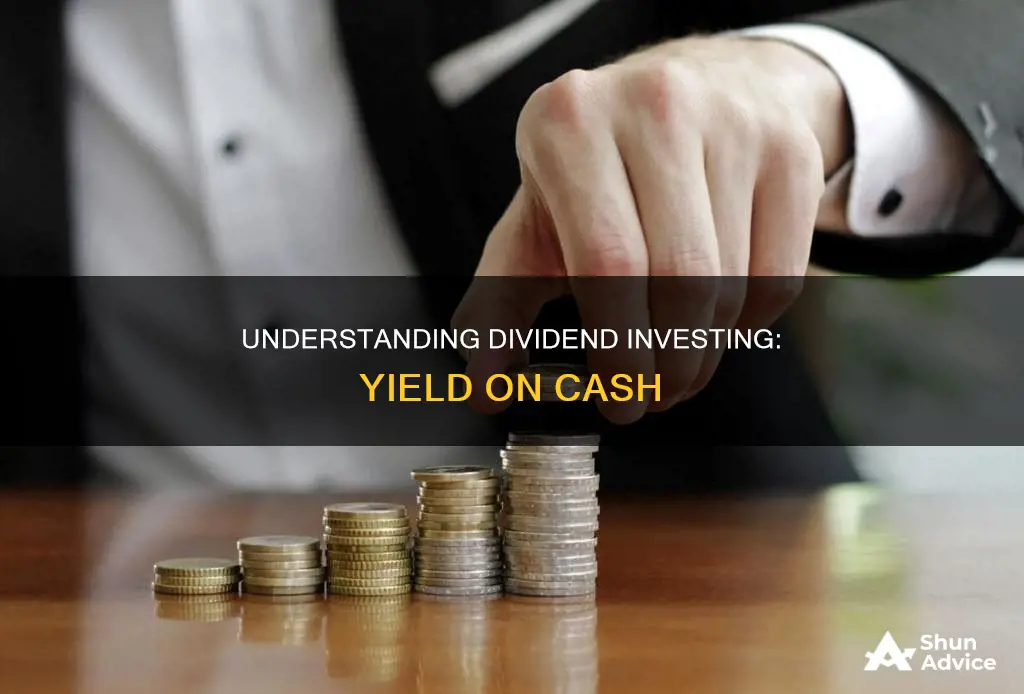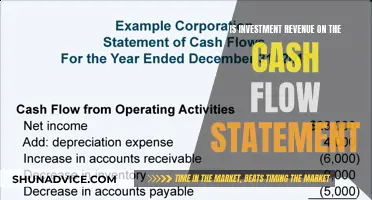
Dividend yield is a ratio that shows how much income you earn in dividend payouts per year for every dollar invested in a stock, a mutual fund, or an exchange-traded fund (ETF). It is a security's annual dividend payment expressed as a percentage of its current price. This percentage yield tells you what your annual return on investment would be at the price you paid for the security.
The dividend yield formula is as follows: Dividend Yield = Dividend/Price x 100.
For example, if a company's share price is $50 and it pays annual dividends of $1.50 per share, the dividend yield would be 3%.
| Characteristics | Values |
|---|---|
| Definition | A financial ratio that measures annual distributions paid by a company relative to the stock’s current price |
| Formula | DY = Annual DPS / Stock Price |
| Purpose | To estimate the amount of dividends expected to be received each year for every dollar invested in a stock |
| Annual Dividends | Paid once per quarter, but the frequency of payments can vary. Some companies pay a monthly dividend, while others pay an annual dividend. |
| Dividend Yield Range | 2% to 6% considered good; currently ranging from 3.0% to 7.5% |
| Impact on Stock Price | Inversely proportional; yield rises when the stock price falls and falls when the stock price rises |
| Payout Ratio | Expresses dividend payments as a percentage of a company's net earnings |
What You'll Learn

Dividend Yield vs. Payout Ratio
Dividend yield and payout ratio are two important measures of dividends that can help investors understand a company's financial health and the potential returns on their investment. While both measures are related, they have distinct features and implications for investors.
Dividend Yield
Dividend yield is a ratio that shows how much income an investor earns in dividend payouts per year for every dollar invested in a stock, mutual fund, or exchange-traded fund (ETF). It is calculated by dividing the total annual dividend amount per share by the price per share. Dividend yield is expressed as a percentage, making it easier for investors to compare the expected returns on their investment. A higher dividend yield indicates a higher income per dollar invested. However, it is important to note that a high dividend yield is not always positive, as it could be a result of a declining stock price or unsustainable dividend payments.
Payout Ratio
The payout ratio, on the other hand, represents the percentage of a company's net income that is paid out as dividends to shareholders. It is calculated by dividing the total dividends paid by the company's net income. The payout ratio provides insights into how much of its earnings a company is distributing to investors and how much it is retaining for reinvestment or other purposes. A payout ratio of 100% indicates that the company distributes all its net income as dividends, while a ratio below 100% means the company retains a portion of its earnings.
Key Differences
While dividend yield focuses on the rate of return for shareholders, the payout ratio indicates how much of its net earnings a company is paying out. Dividend yield is a more commonly used metric and is important for understanding the expected returns on an investment. In contrast, the payout ratio is considered a better indicator of a company's ability to consistently pay dividends in the future, as it is closely linked to the company's cash flow and financial health. A high payout ratio may indicate that a company is not reinvesting enough capital for future profitability, while a low payout ratio could suggest that the company is prioritising growth and reinvesting a larger portion of its earnings.
Both dividend yield and payout ratio are important measures for investors to consider when evaluating dividend-paying stocks. Dividend yield provides information about the expected returns on an investment, while the payout ratio offers insights into the company's financial health and dividend sustainability. By analysing both measures, investors can make more informed decisions about their investments.
Cashing Out Investments: When and How to Do It
You may want to see also

Yields and Inflation
Dividend yields can be an effective hedge against inflation, helping investors preserve their purchasing power over time. Dividend-paying stocks can provide a regular income stream, which can be particularly valuable during periods of rising prices.
When companies pay dividends, they provide investors with a regular income stream that can help maintain purchasing power during inflationary periods. This is especially beneficial for investors on fixed incomes, as their purchasing power may otherwise be eroded by inflation.
However, this is only true when dividend payments increase over time. If a company decides to retain cash flow for growth purposes, a stable dividend yield may be unfavourable during inflationary periods. For example, during the global pandemic, corporations that did not increase their dividend yields eroded the purchasing power of those dividends due to high inflation.
Dividend yield is a ratio that shows how much income is earned in dividend payouts per year for every dollar invested in a stock, mutual fund, or exchange-traded fund (ETF). The yield is presented as a percentage, making it easier to understand the expected return on investment.
It's important to note that a high dividend yield isn't always positive. It could indicate that the company's stock price has been falling or that dividend payments have been increasing at a rate higher than the company's earnings growth. Therefore, investors should carefully evaluate dividend-paying stocks and consider other metrics such as the dividend payout ratio and dividend coverage ratio.
Additionally, dividend-paying stocks may not be the best option for investors seeking high growth. High-growth companies typically reinvest their profits into the business instead of distributing them as dividends. As a result, they may offer greater potential for stock price appreciation, although they carry more risk.
In summary, dividend yields can be a useful tool for investors to maintain their purchasing power during inflationary periods, but it's important to carefully evaluate the underlying health and growth prospects of the company offering the dividends.
Maximizing Cash Value Life Insurance: A Smart Investment Guide
You may want to see also

Types of Dividend Payments
Dividends can come in various forms, with cash dividends being the most common. Here is a list of the different types of dividend payments:
Cash Dividends
Cash dividends are the most common type of dividend payment. They involve the transfer of a cash amount to the shareholders, usually on a quarterly basis, although some companies may opt for monthly, semi-annual, or one-time lump-sum payments. Cash dividends provide shareholders with a direct return on their investments and a regular income stream.
Stock Dividends
Stock dividends, also known as bonus shares, are distributed to shareholders in the form of additional shares instead of cash. Shareholders receive these shares in proportion to their current holdings, increasing their ownership stake in the company without altering their proportional ownership. Stock dividends are often issued when a company wants to reward shareholders while conserving cash reserves.
Liquidating Dividends
Liquidating dividends, or liquidation dividends, are paid to shareholders when a company is in the process of winding down its operations. In this case, the company will return the amount that shareholders originally contributed, and these dividends are typically not taxable.
Special Dividends
Special dividends are one-time payments made by a company when it has excess cash or profits beyond its regular distributions. Special dividends are typically larger than regular dividends and are not expected to recur. They are often the result of exceptional events such as asset sales or windfalls.
Property Dividends
Property dividends involve the distribution of assets or property, such as real estate or other valuable assets, to shareholders instead of cash or additional shares. This allows shareholders to directly benefit from the company's assets.
Scrip Dividends
Scrip dividends give shareholders the option to receive additional shares in the company, often at a discount, or a cash payment at a later date. Scrip dividends usually involve the issuance of newly created shares, which may dilute the ownership of existing shareholders.
Preferred Dividends
Preferred dividends refer to fixed, regular payments made to holders of preferred shares or preferred stock. These dividends are prioritised over common dividends and provide a higher level of income stability for these shareholders.
How Cash App Investing Works for Beginners
You may want to see also

Dividend Growth Rate
The dividend growth rate is the annualised percentage rate of growth of a particular stock's dividend over a period of time. It is an important metric for determining a company's long-term profitability and is a key input for stock valuation models such as the dividend discount model.
Calculating the dividend growth rate involves taking an average or using a more precise geometric method. The linear method involves calculating the growth from one year to the next using the following formula:
Dividend Growth = DividendYearX / (DividendYear(X - 1)) - 1
For example, if a company's dividend payments over the last five years were $1.00, $1.05, $1.07, $1.11, and $1.15, the growth rates for each year would be:
- Year 1: N/A
- Year 2: 5%
- Year 3: 1.9%
- Year 4: 3.74%
- Year 5: 3.6%
The average of these annual growth rates is 3.56%.
A history of strong dividend growth can indicate future dividend growth and long-term profitability. However, investors should be cautious as a long history of dividend growth may force companies to increase payouts during harsh economic times, which can be unsustainable.
Cash App: Investing Age Requirements and More
You may want to see also

Dividend Tax Implications
Dividends are typically taxed as ordinary income, at your marginal tax rate. However, the specifics of dividend tax vary depending on your location, and the type of dividend.
In the US, qualified dividends are taxed at a lower rate than ordinary income, ranging from 0% to 20% depending on the investor's tax bracket. Non-qualified dividends, on the other hand, are taxed at the individual's regular income tax rate.
In Canada, dividends are taxed according to the type of dividend (eligible or non-eligible), the province you live in, and your marginal tax rate. Eligible dividends are paid out by large Canadian businesses that pay higher corporate taxes. They are taxed more favourably than non-eligible dividends, which are paid out by Canadian private corporations (small businesses) that pay corporate tax at a lower rate.
Dividends received in tax-advantaged accounts, such as individual retirement accounts or 401(k)s in the US, are not taxed until withdrawals are made. Similarly, in Canada, if you hold your dividend shares in a Registered Retirement Savings Plan (RRSP), you won't have to pay any tax on dividends received until the funds are withdrawn from the account. And if you hold your shares in a Tax-Free Savings Account (TFSA), the dividends are tax-free, even when withdrawn.
Unlocking Cash Flow Secrets for Smart Investments
You may want to see also
Frequently asked questions
The dividend yield is a financial ratio that shows how much income you earn in dividend payouts per year for every dollar invested in a stock, mutual fund, or exchange-traded fund (ETF). It is expressed as a percentage of the company's annual dividend compared to its share price.
The dividend yield is calculated by dividing the total annual dividend amount of a stock or fund in dollars by the price per share.
Yields from 2% to 6% are generally considered good, but there are other factors to consider, such as the company's financial health and your investment goals.
Dividends are typically paid out on a quarterly basis, but they can also be paid out annually, semi-annually, or monthly.
The dividend rate, or simply dividend, refers to the total amount of money received by investors as income from owning shares of a dividend-paying company. It is expressed as a dollar figure. On the other hand, the dividend yield is expressed as a percentage and represents the ratio of a company's annual dividend to its share price.







